|
|
|
Sort Order |
|
|
|
Items / Page
|
|
|
|
|
|
|
| Srl | Item |
| 1 |
ID:
177197


|
|
|
|
|
| Summary/Abstract |
This essay offers a reading of advertisements of wearable technologies, or prostheses, designed to enhance sexual pleasure and physical health in Tibbi Dunya Lahore, an Urdu-language medical periodical. It contrasts the conception of the body implicit in these advertisements with that of earlier medieval and early modern discourses on sex. This juxtaposition of historically disparate discourses renders visible the colonial transformations of sexual subjectivity that Urdu print advertising presents. By juxtaposing these medical advertisements with earlier medico-moral discourses, one can see a shift away from technologies of the self, directed at managing the interiority of desire, towards the consumption of ‘small technologies’ that exteriorise pleasure. This material suggests not only the mutual implication of ars erotica and scientia sexualis, but also the subversion of both by the commodification of pleasure.
|
|
|
|
|
|
|
|
|
|
|
|
|
|
|
|
| 2 |
ID:
177190


|
|
|
|
|
| Summary/Abstract |
In Hinduism, sindoor is a symbol of a married woman’s chastity, love and fidelity towards her husband. This potent mark inscribed on the forehead and in the parting of a woman’s hair serves as a reminder of her heterosexual identity, unavailability to other men, and the ownership of her body by her husband. Problematising how this heteropatriarchal imperative has complicated the bodily boundaries between the personal, social and cultural, this article explores the religious, nationalist and transnational politics of the appropriation of sindoor. The article analyses literary texts, Indian cinema classics and advertisements to critically explore how the sindoor mark is constituted by a complex interplay of race, gender, sexuality, religion, class, caste and nationality, inviting one to collaborate in the perpetuation of the doing and undoing of feminism.
|
|
|
|
|
|
|
|
|
|
|
|
|
|
|
|
| 3 |
ID:
177193


|
|
|
|
|
| Summary/Abstract |
This article explores the links forged between members of the Ghadar Movement and Mexican radical activists and organisers in North America during the early twentieth century. It argues that during the opening two decades of the century, Mexico and its convulsed politics offered radical anti-colonial Indian activists in North America an inspiring example and a source of important tactical, symbolic and ideological resources in their fight against imperialism and oppression. By exploring the points of contact, proximity and affinity between Indian and Mexican radicals in the years prior to and immediately after 1917, I argue that the turbulent politics of revolutionary Mexico and the thrust of Indian anti-colonialism came together in marginal but meaningful ways at a time of global revolutionary change.
|
|
|
|
|
|
|
|
|
|
|
|
|
|
|
|
| 4 |
ID:
177199


|
|
|
|
|
| Summary/Abstract |
The three-cornered nature of decolonisation—the decline of European power, the culmination of US hegemony, and the immediate appropriation of the new nation by a post-colonial elite—was foundational to G.S. Ghurye’s detailed riposte to Kinsey’s Sexual Behavior in the Human Female. I show how the ‘Father of Indian Sociology’ marshalled statistics, sexology and Sanskrit, along with a static notion of heterosexuality, to caricature whiteness and thereby attack US power. More delicately, however, he directed his critique toward reshaping the identity and even the location of caste. I show how, through an act of translation, Ghurye deployed ‘the’ American orgasm to empower a new ruling class that could project itself as casteless and thus lay claim to a national–colonial mandate.
|
|
|
|
|
|
|
|
|
|
|
|
|
|
|
|
| 5 |
ID:
177191
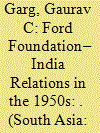

|
|
|
|
|
| Summary/Abstract |
This paper investigates the development of a close relationship between the Ford Foundation—the world’s richest and most internationally oriented philanthropic organisation in the Cold War era—and India in the 1950s. Unlike existing literature on private foundation–recipient country relationships, which overwhelmingly focusses on the donor perspective, this essay explores the recipient perspective, thereby contributing to the emerging literature on Third World agency in international politics. Complicating the idea that recipient countries were overwhelmingly interested in aid maximisation, this article shows that India moved closer to the Ford Foundation in order to fulfil diplomatic rather than aid-related objectives.
|
|
|
|
|
|
|
|
|
|
|
|
|
|
|
|
| 6 |
ID:
177198
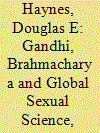

|
|
|
|
|
| Summary/Abstract |
This essay explores the evolution of Gandhi’s philosophy of brahmacharya (celibacy) after World War I. I argue here that Gandhi broadened his understanding of brahmacharya after he assumed leadership of the nationalist movement, rendering it into a concept that was applicable to the wider population of India rather than just to himself and a set of especially disciplined activists. A major reason for this development was Gandhi’s concern with deflating the claims of sexual science and birth control at a time when global sexology was gaining a foothold in Indian middle-class society. In this context, Gandhi specifically came to contest the notion that human ‘nature’ made brahmacharya inapplicable to ordinary people, suggested that husbands and wives could follow brahmacharya even while married, and insisted that the general practice of brahmacharya was essential to the collective health of the Indian nation. In the process, he imparted a significant eugenic component into his philosophy.
|
|
|
|
|
|
|
|
|
|
|
|
|
|
|
|
| 7 |
ID:
177196


|
|
|
|
|
| Summary/Abstract |
In this paper, I explore the ways in which queer sex acts and orientations come to be coded through other modes of signifying excess in colonial and nationalist discourse. I explore the way in which food and sex are held on a continuum that ties gluttony to abstinence, creating the standards for respectable sexuality and a map for flouting them. Fundamentally, I look at how sex and food are conflated, especially when enjoyed or imagined in ways outside the norm of conventional morality. Moreover, I examine the terms through which this correlation is translated into a broader framework for thinking about the body in its private and shared forms.
|
|
|
|
|
|
|
|
|
|
|
|
|
|
|
|
| 8 |
ID:
177194


|
|
|
|
|
| Summary/Abstract |
This introduction to ‘Translating Sex’ places the six essays included in this special section in the context of the history of sexuality in the Indian subcontinent, and argues for a need to write more comprehensive histories of sexology—the field of inquiry which promoted the understanding of sex as a ‘scientific object’ around the globe at the turn of the twentieth century. It identifies the divergent materials covered in, and the common grounds occupied by, the six essays that deal with sex as a translated object of knowledge; considers the history of vernacular sexology; and showcases the ubiquity of sexology in socio-cultural, political and literary debates in the Indian subcontinent in the first half of the twentieth century. It argues that by locating sexology in Indian history, we can render ‘sexuality’ a more useful category of analysis for this context as well as comprehend what might be termed the sexuality of Indian history.
|
|
|
|
|
|
|
|
|
|
|
|
|
|
|
|
| 9 |
ID:
177200
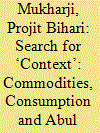

|
|
|
|
|
| Summary/Abstract |
Abul Hasanat (1905–?) was one of the most widely read Bengali sexologists. Having started researching in British India, he subsequently became a citizen of Pakistan and later of Bangladesh. He continued to research and publish throughout these changing political contexts. In this paper, I explore the difficulties in adequately ‘contextualising’ Hasanat’s sexology and propose instead the notion of a ‘material sexscape’ as the appropriate frame within which to locate his work.
|
|
|
|
|
|
|
|
|
|
|
|
|
|
|
|
| 10 |
ID:
177195
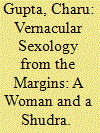

|
|
|
|
|
| Summary/Abstract |
This article centres on the Hindi sexology writings of a woman, Yashoda Devi, and a Shudra, Santram B.A. In the context of an efflorescence of vernacular sexology literature in early twentieth-century North India, it explicates how their writings moved along different registers, whereby they envisaged a heterosexual ethics that relied on utopian and dystopian descriptions of modernity. Sexology in Hindi, particularly when construed from the margins, reified, constructed, destabilised and questioned sexual norms. The article argues that while largely operating within reformist sexology frames, their writings at times punctured dominant upper-caste, male-centric authority and created frictions in normative equations. Together, their writings contribute significantly to creating a vernacular archive of sexual sciences in India.
|
|
|
|
|
|
|
|
|
|
|
|
|
|
|
|
| 11 |
ID:
177192
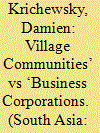

|
|
|
|
|
| Summary/Abstract |
India’s current ‘pro-business’ development regime has been both challenged by depictions of malevolent corporations oppressing helpless village communities and legitimised by depictions of socially responsible corporations ‘developing’ grateful backward communities. To overcome these contradictory narratives, which fail to account for the intricate relationships between villagers and corporate actors, the article analyses how these narratives are constructed in interaction with local conflicts surrounding industrial activity. Guided by a framework based on social systems theory, a detailed study of two cement plants located in Chhattisgarh shows how this interaction operates through multiple discursive layers, which vary in terms of their degree of specification/generalisation and concreteness/abstraction.
|
|
|
|
|
|
|
|
|
|
|
|
|
|
|
|
|
|
|
|
|